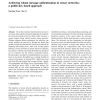901 search results - page 93 / 181 » Minimum power configuration in wireless sensor networks |
TPDS
2008
13 years 8 months ago
2008
The localization of sensor nodes is a fundamental problem in sensor networks and can be implemented using powerful and expensive beacons. Beacons, the fewer the better, can acquire...
SENSYS
2003
ACM
14 years 2 months ago
2003
ACM
Wireless sensor networks promise fine-grain monitoring in a wide variety of environments. Many of these environments (e.g., indoor environments or habitats) can be harsh for wire...
WINET
2010
13 years 7 months ago
2010
Given the extremely limited hardware resources on sensor nodes and the inclement deploying environment, the adversary Denial-of-Service (DoS) attack becomes a serious security thre...
BROADNETS
2005
IEEE
14 years 2 months ago
2005
IEEE
— Lightweight protocols that are both bandwidth and power thrifty are desirable for sensor networks. In addition, for many sensor network applications, timeliness of data deliver...
PIMRC
2010
IEEE
13 years 6 months ago
2010
IEEE
In this paper, a new type of collaboration in wireless sensor networks (WSN) is suggested that exploits array processing algorithms for better reception of a signal. For receive co...

